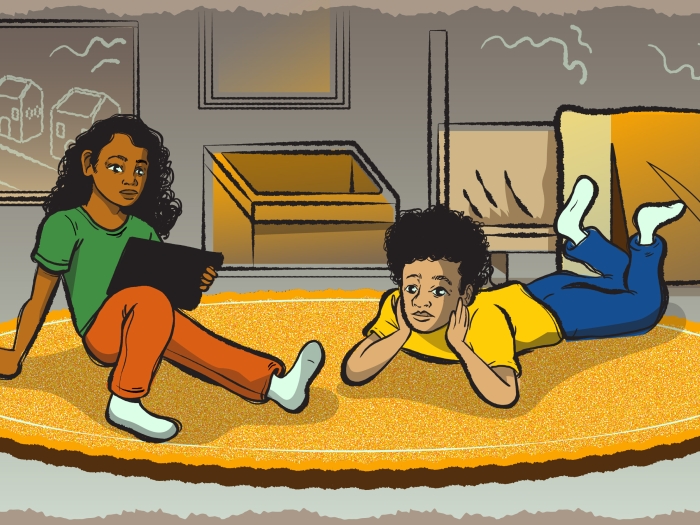Data-driven approach suggests more locked-storage assistance is needed, as well as tailored risk reduction approaches for those with memory and mental health concerns.
2:42 PM
Author |

Anyone who's over 50 today remembers a time when dying in a car or motorcycle crash was all too common a fate.
But thanks to efforts to reduce drunk driving, build safer roads, place restrictions on young drivers, make airbags and other safety equipment standard, and improve emergency care, the toll of deaths and injuries from motor vehicle collisions has dropped dramatically in the past 50 years.
Each of those changes, and others, started with research. By following the data, the United States has reduced the risk that crashes will happen in the first place – or that the ones that do happen will lead to life-threatening injuries.
Could the same thing work to reduce deaths from firearms, which are up 15% since 2014?
Yes, said University of Michigan expert Patrick Carter, M.D., in a recent talk to an audience made up mainly of older adults. "We can use the same type of scientific approach to reducing the potential for injuries that result from firearms," he said.
And while more research is badly needed, he explains, researchers already know some specific steps that might reduce the toll among people over 50, if individuals and communities take them.
Nearly 33% of people who die from firearm injuries in the U.S. are over 50, he explained. About 84% of firearm deaths among older adults are suicides, with another 14% being homicides, including domestic violence.
"Access to a firearm by at-risk individuals at high-risk times is the single biggest modifiable risk factor for preventing firearm deaths" said Carter, an emergency physician and injury prevention researcher. Of all suicides among older adults, 70% involve a firearm – and suicide attempts involving a firearm are much more likely to be fatal than those using other means.
Carter and his colleagues at the U-M Institute for Firearm Injury Prevention have launched a major effort to study all aspects of firearm injury and death in the U.S., through some of the first major federal research grants given in decades for this kind of work. They're also helping to organize a nationwide research conference on the topic for this fall.
They recently published findings about gun ownership, storage and use among older adults, and their views about potential ways to reduce risk through public policies and personal action.
In all, 37% of people over 50 own guns or live with someone who does, they found.
3 key areas for potential risk reduction
1. Increase locked storage
The U-M team's research shows that 24% of firearm owners over age 50 regularly store at least one of their firearms loaded and unlocked, which Carter noted has shown to increase the potential risk of accidental or intentional injury.
Homes where firearms are kept loaded are over nine times as likely to be the site of a suicide, research by other groups has also shown. This includes teens who gain access to firearms owned by parents, grandparents or other relatives; 75% of teen suicides involve a relative's firearm.
Based on these data and others, firearm owners of any age should keep their weapons unloaded, locked with a gun lock or in a locked gun safe or cabinet, and separate from ammunition, Carter says.
He also points out an increasing opportunity for firearm owners to store their weapons at gun shops or firing ranges, to keep them available for shooting sports or hunting but out of the house, especially during high-risk times when someone in the household may be experiencing a mental health crisis.
And he notes that the recent U-M study showed that 63% of older firearm owners, and an even higher percentage of those who live with a firearm owner, said they'd be comfortable having a health care provider counsel them about safe firearm storage. The percentage was lower, however, among those who store their firearms unlocked and loaded.
2. Focus on older adults with dementia, depression or other major health concerns
Suicides among older adults are more often linked to a history of depression or a long-term physical impairment, Carter says. Social isolation, alcohol or drug issues, and stressful life events involving finances or family members also raise suicide risk in older adults.
Dementia is a risk factor for both homicide and suicide in older adults, Carter says, especially in its later stages when older adults can become agitated, paranoid, and aggressive.
Older adults facing any of these conditions and their loved ones, should talk with one another and with health care providers about the increased risk and steps they could take to reduce it.
"We don't have a standardized assessment tool to determine if someone has the functional ability to handle firearms, but we could use the clinical dementia rating scale, the same as we do for assessing skills among older adults for driving," Carter said.
His team's recent study showed that 81% of older firearm owners, and 92% of non-firearm owners, support efforts to remove firearms from the homes of older adults who have dementia or other causes of confusion.
Turning a firearm in to police for safe disposal, or working with police to transfer ownership legally, is an option.
3. Train health providers in firearm counseling for older patients
Even if older people say they're receptive to talking with a health care provider about reducing firearm risks, many clinicians aren't equipped to have those conversations, Carter said.
That's why the team at the FACTS Consortium, which includes U-M firearm researchers and others, developed training materials and made them available on their website childfirearmsafety.org. These include videos to educate clinicians on how to counsel in a respectful and nonjudgmental way and help older patients think ahead.
"About 80% of older adults have no plan for what to do if they become unsafe to handle firearms," said Carter. "We need to help them think about and develop a 'retirement plan' for their firearms and what will happen to their firearms when they reach a stage where they are not able to own and operate them safely."
The new Firearm Life Plan site created by the University of Colorado is a potential tool to use.
Health providers who get training that makes them more attuned to signs of anger management issues, domestic violence risk or suicidality can also help intercede before a crisis. This is especially pertinent in places where a state or municipality has a "red flag" law that allows firearms to be temporarily removed by police from someone who is deemed to be a potential danger to themselves or others until the risk has been reduced.
Paper cited: "Firearm ownership, attitudes, and safe storage practices among a nationally representative sample of older U.S. adults age 50 to 80," Preventive Medicine. DOI: 10.1016/j.ypmed.2022.106955
Like Podcasts? Add the Michigan Medicine News Break on iTunes, Google Podcasts or anywhere you listen to podcasts.

Explore a variety of health care news & stories by visiting the Health Lab home page for more articles.

Department of Communication at Michigan Medicine
Want top health & research news weekly? Sign up for Health Lab’s newsletters today!





